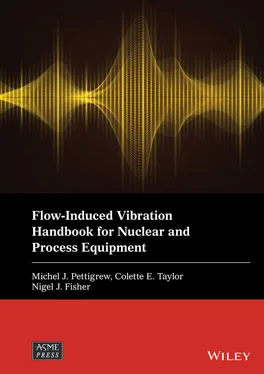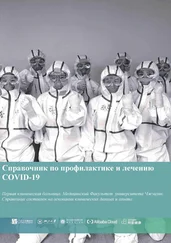1 ...6 7 8 10 11 12 ...20 Such analysis requires time domain non‐linear simulation of the tube dynamics in which the details of sliding‐friction, impact, viscous‐shear and squeeze‐film forces between tube and tube supports are modelled. Unfortunately, non‐linear simulations are difficult and some of the detailed information is lacking. Furthermore, the required non‐linear analysis is not yet in the form of a practical design tool. Some progress has been made in this area with the development of codes, such as VIBIC (Fisher et al, 1992), H3DMAP (Sauvé et al, 1987) and EPRI SG FW (Rao et al, 1988) to predict fretting wear of heat exchanger tubes.
In the future, we believe that all vibration analyses will consider non‐linear simulation of the dynamic interaction between tubes and supports and will include a fretting‐wear damage prediction. This kind of analysis is now done by specialists for very critical or very expensive components, such as nuclear steam generators. Fretting‐wear damage prediction is discussed in Chapter 12.
For the time being, quasi‐linear vibration analyses are used by the industry for most heat exchangers. Quasi‐linear analysis requires the formulation of tube‐to‐support dynamic interaction forces, such as damping, in terms of equivalent linear values. We have found this approach to be reasonable in practice for the prediction of overall tube vibration response and critical velocities for fluidelastic instability. Such analysis is adequate to eliminate most vibration problems. However, long‐term fretting‐wear damage and tube life can only be predicted in an approximate manner. Tube vibration measurements in real heat exchangers show generally good agreement between measured and predicted frequencies using the quasi‐linear approach.

Fig. 1-12 Multi‐Span Heat Exchanger Tube with N Spans and N‐1 Clearance Supports.
1.3.2 Other Nuclear and Process Components
Other process and nuclear system components, such as nuclear fuels, reactor internals, and piping systems, are often multi‐span beams with intermediate clearance‐type supports (e.g., piping supports, fuel bearing pads and support grids). Analysis of these components is similar to that of multi‐span heat exchanger tubes.
1 Au‐Yang, M.K., 2001, “Flow‐Induced Vibration of Power and Process Plant Components: A Practical Workbook,” ASME Press, New York, NY, USA.
2 Blevins, R. D., 1990, “Flow‐Induced Vibration,” 2nd Edition, Van Nostrand Reinhold Company, New York, NY, USA.
3 Chen, S. S, 1987, “Flow‐Induced Vibration of Circular Structures,” Hemisphere Publishing Corporation, New York, NY, USA.
4 Fisher, N. J., Ing, J. G., Pettigrew, M. J. and Rogers, R. J., 1992, “Tube‐to‐ Support Dynamic Interaction for a Multispan Steam Generator Tube,” Proceedings of ASME International Symposium on Flow‐Induced Vibration and Noise, Anaheim, California, November 8‐13, 2, pp. 301–316.
5 Kaneko, S., Nakamura, T., Inada, F., Kato, M., Ishihara, K., Nishihara, T., 2014, “Flow‐Induced Vibration,” 2nd Edition, Academic Press, Elsevier, London, UK.
6 Naudascher, E. and Rockwell, D., 1994, “Flow‐Induced Vibration: An Engineering Guide,” A.A. Balkma, Rotterdam, Netherlands.
7 Païdoussis, M. P., 1998, “Fluid‐Structure Interactions: Slender Structures and Axial Flow,” Vol. 1, Academic Press, Elsevier, London, UK.
8 Pettigrew, M. J., 1976, “Flow‐Induced Vibration of Nuclear Power Station Components,” 90thAnnual Congress of the Engineering Institute of Canada, Halifax, NS, Oct. 4‐8, (also Atomic Energy of Canada Report, AECL‐5852)
9 Pettigrew, M. J., and Campagna, A. O., 1979, “ Heat Exchanger Vibration: Comparison Between Operating Experiences and Vibration Analysis,” Proceedings of the International Conference on Practical Experiences with Flow‐Induced Vibrations, Karlsruhe, Germany, 1979 September, (also Atomic Energy of Canada Report, AECL‐6785).
10 Pettigrew, M. J., Sylvestre, Y. and Campagna, A. O., 1977, “Flow-Induced Vibration Analysis of Heat Exchanger and Steam Generator Designs,” 4th International Conference on Structural Mechanics in Reactor Technology, Paper No. F6/1+, San Francisco, California, Aug. 15‐19, (also Atomic Energy of Canada Report, AECL‐5826).
11 Pettigrew, M. J., Carlucci, L. N., Taylor, C. E. and Fisher, N. J., 1991, “Flow‐Induced Vibration and Related Technologies in Nuclear Components,” Nuclear Engineering and Design, 131, pp. 81–100.
12 Rao, M. S. M., Steininger, D. A., and Eisinger, F. L., 1988, “Numerical Simulation of Fluidelastic Vibration and Wear of Multispan Tubes with Clearances at Supports,” Proceedings of the ASME Symposium on Flow‐Induced Vibration and Noise‐1988: Vol. 5, Flow‐Induced Vibration in Heat‐Transfer Equipment, pp. 235–250.
13 Sauvé, R. G. and Teper, W. W., 1987, “Impact Simulation of Process Equipment Tubes and Support Plates‐A Numerical Algorithm”, Journal of Pressure Vessel Technology, 109, pp. 70–79.
1 1CANDU‐BLW = Canada Deuterium Uranium – Boiling Light‐Water is a registered trademark of Atomic Energy of Canada Limited.
2 2CANDU‐PHW = Canada Deuterium Uranium – Pressurized Heavy‐Water is a registered trademark of Atomic Energy of Canada Limited.
2 Flow‐Induced Vibration of Nuclear and Process Equipment: An Overview
Michel J. Pettigrew and Colette E. Taylor
Failures due to excessive vibration must be avoided in process equipment, preferably at the design stage. Thus, a comprehensive flow‐induced vibration analysis is required before fabrication of process equipment, such as shell‐and‐tube heat exchangers. It must be shown that tube vibration levels are below allowable levels and that unacceptable resonances and fluidelastic instabilities are avoided.
The purpose of this chapter is to summarize our design guidelines for flow‐induced vibration in components operating in gas, liquid, and two‐phase flows. This overview chapter can be used by the designer as a guideline for vibration analysis, by the project engineer to get an overall appreciation of flow‐induced vibration concerns, or by the plant operator to understand tube failures. This overview pertains to critical regions of shell‐and‐tube heat exchangers, such as nuclear steam generators (SG), heat exchangers (HX), coolers, condensers and moisture‐separator‐reheaters (MSR).
2.1.1 Flow‐Induced Vibration Overview
The vibration behavior of process system components is governed by vibration excitation mechanisms and by damping mechanisms. Generally, in components such as heat exchangers there are several significant damping mechanisms: 1) friction damping between tube and tube support, 2) squeeze‐film damping at the support, 3) viscous damping between tube and shell‐side fluid, and 4) damping due to two‐phase flow.
Generally, the flow in heat exchanger tube bundles can be parallel (axial flow) or transverse (cross flow) to the tube. In nuclear steam generators, the flow is axial for a large portion of the tube bundle. Vibration excitation forces induced by axial flow are relatively small in heat exchangers. Thus, vibration excitation mechanisms in axial flow may generally be neglected. The vibration behavior is clearly governed by cross‐flow vibration excitation mechanisms.
Several vibration excitation mechanisms are normally considered in heat exchange components such as tube bundles in cross flow, namely: 1) fluidelastic instability, 2) periodic wake shedding, 3) turbulence excitation, and 4) acoustic resonance. Fluidelastic instability is by far the most important mechanism and must be avoided in all cases. Periodic‐wake‐shedding resonance may be of concern in liquid cross flow where the flow is relatively uniform. It is not normally a problem at the entrance region of steam generators because the flow is very non‐uniform and quite turbulent (Pettigrew et al, 1973). Turbulence may inhibit periodic wake shedding in tube arrays. Periodic wake shedding is generally not a problem in two‐phase flow except at very low void fractions (i.e., ε g< 15%) or under unusual conditions, as discussed in Chapter 11. Turbulence excitation may be important in liquid cross flow. Periodic wake shedding resonance and turbulence excitation are not usually of concern in gas flow since the fluid density is generally low, thereby resulting in relatively small excitation forces. However, both mechanisms should be considered in some gas heat exchangers such as MSRs where relatively high fluid densities exist. Acoustic resonance must be avoided in heat exchangers with shell‐side gas flow. However, it is generally not a problem in liquid and two‐phase heat exchangers.
Читать дальше













